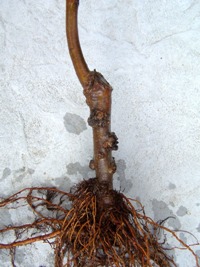Rootstocks
Apples
do not reproduce true to seed; if you plant a seed from a good apple the
tree it produces will bear apples, but they may taste much different
than the one the seed came from, and usually taste terrible, like grass
or cotton. The only way to get a tree identical to the one the
apple came from is to clone it by grafting, where a piece is taken from
that tree and grafted onto another tree's roots. These roots are
called the "rootstock" or "understock".
For
centuries rootstocks were grown from common apple seeds from eating
apples. They can make a very vigorous tree with deep roots that
are adaptable to poor soils and drought. But since each seed is a
different variety, the performance of the rootstocks can also be
variable, some doing well and others poorly. So over the years
apple varieties were identified that produced seeds that bear pretty
close to type, where the seeds produce almost the same tree every time
that has uniform, vigorous, well-adapted roots. Bittenfelder
and Grahams Jubilee
were the variety used in Europe and Antonovka favored in Russia
for 500 years because it withstood the harsh winters. These two varieties are
still favored for growing rootstocks from seed and produce a long-lived
tree, 100 years or more. Seedling rootstocks have the added
benefit of being considered virus-free.
However
clonal rootstocks have been also used for centuries, varieties valued
because they produce a smaller tree, which is called "dwarfing"
or "size-controlling". These rootstocks must be propagated
vegetatively through mound layering or stoolbeds, where the tree is cut
back severely causing it to send up suckers, which are then rooted in
sawdust. Because they are propagated vegetatively there is the
possibility of passing on viruses from parent to offspring, and so the
best suppliers carry stock that has been cleaned up by virus-indexing
and field-tested often for viruses (virus certified). The
dwarfing effect of clonal rootstocks is measured against a tree on
seedling rootstock, which is considered 100% and can be between 8-10
meters tall.
Tropic conditions have a dwarfing effect on apple trees, and size control is not often an issue. Apples are grafted onto both seedling and clonal rootstock and easily kept to three meters tall by culture methods such as inducing heavy cropping. Some clonal rootstocks have the added benefit of being resistant to wooly aphid, an underground pest in some locations. There are are some very dwarfing rootstocks that produce a tree 1.5 to 2 meters tall, but they are very delicate, drought susceptible, and poorly anchored and not recommended for the tropics.
The rootstocks we offer are:
 -M111
EMLA A slightly-dwarfing clonal rootstock that produces a tree
80% the size of a seedling tree (but this may vary widely depending on
the variety, crop load, and culture method). It is particularly
adapted to drought conditions and is very well-anchored. It
imparts some slight early-bearing characteristics and is adaptable to
worn out, sandy, or clay soils, but not as much as seedling rootstocks
are. It has been used successfully in the tropics for years and
will start bearing in 3 to 5 years, much earlier however with tropic
varieties like Anna.
-M111
EMLA A slightly-dwarfing clonal rootstock that produces a tree
80% the size of a seedling tree (but this may vary widely depending on
the variety, crop load, and culture method). It is particularly
adapted to drought conditions and is very well-anchored. It
imparts some slight early-bearing characteristics and is adaptable to
worn out, sandy, or clay soils, but not as much as seedling rootstocks
are. It has been used successfully in the tropics for years and
will start bearing in 3 to 5 years, much earlier however with tropic
varieties like Anna.
The "EMLA" designation at the end means it has been virus-indexed and all our suppliers are virus certified. It has a tendency to form aerial burr knots, visible on the trunk in the photo on the left, where it tries to form roots above the ground, causing rough patches of stubble on the trunk. Because of this it should be planted deep, the graft union just above the ground, as the burr knots give insect pests a place to hide. It is resistant to wooly aphid, an underground pest that causes nodules on the roots that slowly starve the tree.
-Seedling
Our seedling rootstocks are on Antonovka, good for producing a healthy, vigorous, long-lived tree.
They produce the most drought-tolerant and adaptable tree, tolerating heavy
clay or light sandy soils, and soils with fertility problems. It
is well-anchored and can live a long time. With some varieties
bearing can be delayed for 4-6 years, but Anna, Dorsett Golden, and
Shell of Alabama will bear the second year even on seedling rootstock.
You will notice a difference in the root structure when compared to a
dwarfing rootstock like M111; the roots on the M111 look like strands on
a mop, where on seedling rootstock they resemble ropes or cables, much
more wild and tough-looking. They can go down 10 meters in good
soil, but will not go very deep in heavy clay soils.
Photos: P18 clonal rootstocks, Winesap tree on seedling rootstock at Cantebury Shaker Village in New Hampshire, Red Topaz on Bud. 9 dwarfing rootstock, M111 rootstock tree, Antonovka seedling rootstock ready for grafting
Home | Order Form | Contact Us
©2021 Kuffel Creek